Paintless Dent Repair (PDR) has become a popular option for many vehicle owners who want to restore their vehicles to their original condition. It is a cost-effective, efficient, and practical method that uses specialized tools and techniques to remove minor and major dents from a vehicle’s body. This ultimate guide to paintless dent repair will provide a comprehensive look at PDR, its advantages, the types of dents and body panels that can be repaired with PDR, and how to find a qualified PDR technician.
You can find more information about our paintless dent repair service here.
History and Future of PDR
We will start by exploring the history of PDR and how it has evolved over the years. We will also look into the future of PDR and the advancements that are being made in the industry, such as new tools and techniques.
Advantages and Best Situations for PDR
We will discuss the advantages of PDR over traditional dent repair, such as faster repair time, lower cost, and maintaining the vehicle’s factory finish. We will also cover the best situations for PDR, such as shallow dents, hail damage, and shopping carts.
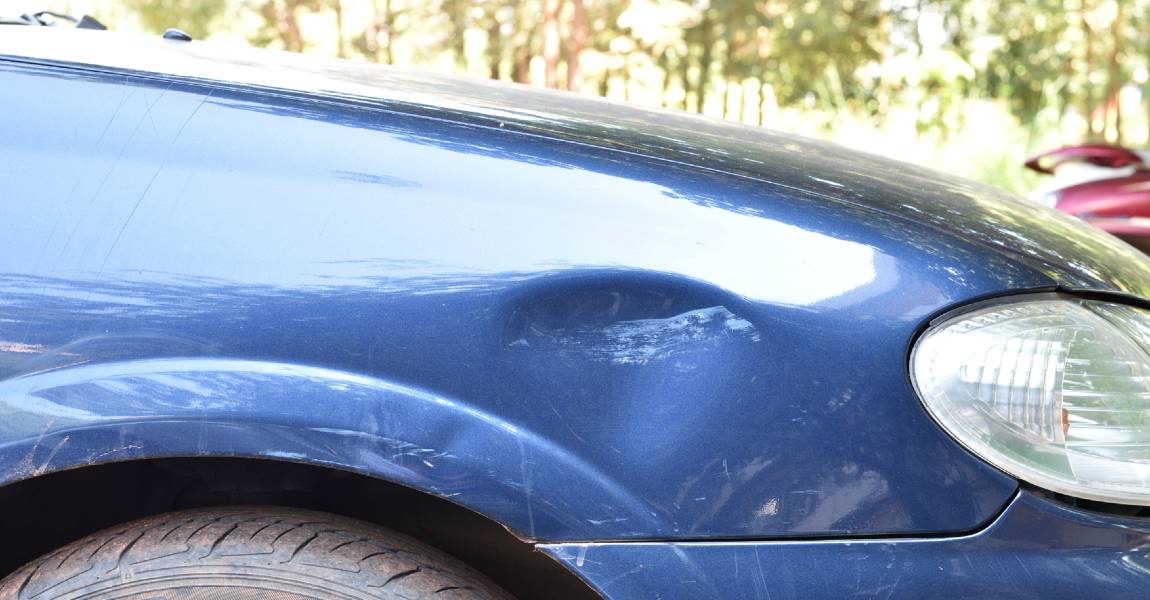
Types of Dents and Body Panels that Can be Repaired with PDR
We will provide an overview of the types of damage that can be repaired using PDR, including crease dents, single dents, and severe dents. We will also cover the different body panels that can be repaired with PDR, such as doors, hoods, and fenders.
Not all Materials can be Fixed with PDR
We will review the materials that cannot be repaired using PDR, such as body fillers and paint damage that is too severe.
Average Cost and Finding a Qualified PDR Technician
We will discuss the average cost of PDR and how it varies based on the dent’s severity and the repair’s location. We will also provide tips on how to find a qualified PDR technician, such as checking their experience and training.
Common Misconceptions and Differences Between PDR and Traditional Dent Repair
We will address common misconceptions about PDR, such as it only works for small dents. We will also differentiate PDR from traditional dent repair, including the use of specialized tools and the lack of filling or painting.
Key Takeaways
- PDR is a cost-effective, efficient, and practical method of removing dents from a vehicle’s body.
- This comprehensive guide covers the history and future of PDR, advantages and best situations for PDR, types of dents and body panels that can be repaired with PDR, materials that cannot be repaired by PDR, average cost, finding a qualified PDR technician, common misconceptions, and the difference between PDR and traditional dent repair.
Introduction to Paintless Dent Repair (PDR)
Paintless Dent Repair (PDR) is a non-invasive method of removing dents from a vehicle without the need for filling or painting. PDR involves using specialized tools and techniques to massage the dent out from the backside of the panel. This process is often quicker and more cost effective than traditional dent repair methods while also maintaining the vehicle’s original factory finish.
PDR is ideal for repairing minor dents, such as door dings and small creases, caused by hail or other external factors. The technique can be used to remove dents from various types of body panels, including doors, hoods, and fenders. The repair process is low-risk and preserves the vehicle’s structural integrity, making it a popular choice for car owners looking to maintain the value of their vehicle.
Key Takeaways:
- PDR is a non-invasive method for removing minor dents and door dings
- More cost-effective than traditional dent repair methods and maintains the vehicle’s factory finish.
The History of PDR
Paintless Dent Repair, or PDR is a technique used to repair dents on vehicle body panels without having to repaint or use traditional body fillers. Its origins date back to the early 20th century when car manufacturers began using lighter and more flexible metals to produce automobiles. This shift towards lighter metals created a need for new repair techniques that could address dents without damaging the vehicle’s paint job.
The earliest forms of PDR involved using metal rods to push out dents inside the vehicle’s body panel. This process required a lot of skill and precision as damaging the panel or paint job was easy. Over time, improvements were made to the technique, including using specialized tools like body picks and glue pullers. These tools helped make the process more efficient and safer. The popularity of PDR took off in the 1980s and 1990s as the technique became more refined and more people saw the benefits of using PDR over traditional dent repair methods. Today, PDR continues to evolve and improve, and with advancements in technology, it may become an even more popular repair option in the future.
Key Takeaways:
- PDR originated in response to the use of lighter and more flexible metals in vehicles
- The early forms of PDR involved using metal rods to push out dents
- Specialized tools were later developed to make the process more efficient and safer, and PDR became more popular in the 80s and 90s
- PDR continues to evolve and may become even more popular with advancements in technology
The Future of PDR
As car manufacturing continues to evolve, with a shift towards using even lighter and more flexible materials in vehicles, the popularity of PDR is likely only to grow. This is because these materials are more prone to denting yet are more difficult to repair using traditional methods that involve filling the dents with body fillers and repainting the entire panel. PDR, however, can remove dents without damage to the paint or the underlying metal, leaving the panel in its original condition. With the environmental focus on reducing vehicle weight, the use of even lighter materials in the future seems inevitable. Therefore the popularity of PDR looks set to continue.
Advancements in technology are also set to revolutionize PDR even further, making the process more efficient and effective. For example, the use of artificial intelligence and machine learning could help more quickly identify the best approach to removing a dent. At the same time, 3D imaging and printing could allow the creation of more precise and customized tools. Additionally, developing new adhesives and materials could lead to the creation of even more effective glue pullers, which could expand the scope of PDR to include dents that are currently considered too severe to repair using this technique. With such advances on the horizon, the future of PDR looks bright.
Key Takeaways:
- The popularity of PDR is likely to grow as car manufacturers continue to shift towards using lighter and more flexible materials in vehicles.
- Advancements in technology, such as artificial intelligence and 3D printing, could make PDR even more efficient and effective in the future.
How Does PDR Work?
PDR is a popular technique used to repair dents and dings in vehicles without the need for traditional body fillers or paint jobs. The process involves using specialized tools and techniques to gently massage the dent out from the inside of the panel, returning the vehicle to its original condition.
The first step in the PDR process is to assess the type and severity of the dent. Once identified, specialized tools such as metal rods, glue pullers, and body picks are used to access the inside of the panel, allowing the technician to begin pushing, pulling, and tapping the dent out. These tools and techniques are used gradually to reshape the metal back into its original form. It’s important to note that skilled technicians take a gentle approach to the process, as excessive force can damage the paint or finish of the car.
Key Takeaways:
- PDR uses specialized tools and techniques to massage dents out from the inside of the panel gently.
- Skilled technicians take a gentle approach, gradually using pushing, pulling, and tapping techniques to reshape the metal into its original form.
The Advantages of PDR
PDR is a technique used to remove dents and dings from vehicles without the need for traditional body fillers or other costly measures. This innovative process requires specialized tools that gently manipulate the metal back into its original form. In this article, we will discuss the advantages of PDR and why it’s worth considering for your next dent repair job.
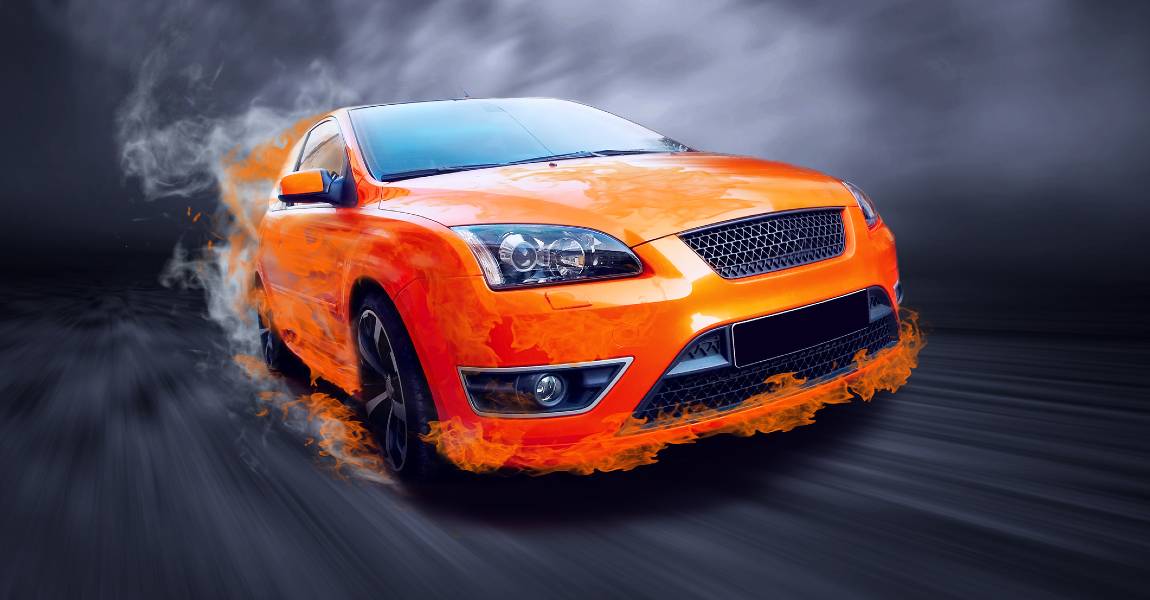
1. Preservation of the Original Paint Job
PDR allows technicians to fix dents and dings without the need to touch up the paint or applying a new coat altogether. This makes it an excellent option for those who want to maintain the factory finish of their car while being cost-effective. Moreover, it also eliminates the possibility of mismatched paint or problems with the clear coat.
Key Takeaways:
- Using PDR, technicians can repair dents and dings without touching up the paint or applying a new coat
- Cost-effective and helps avoid mismatched paint problems.
2. Shorter Turnaround Time and Timely Repairs
Traditional dent repair processes can take several days to complete, depending on the severity of the damage. PDR, however, can be completed within hours, often taking no more than a day to finish. As a result, it allows car owners to get their vehicles back in functional and aesthetically pleasing condition quickly. PDR is ideal for those with busy schedules or who want to avoid extensive wait times for their vehicle to be repaired.
Key Takeaways:
- PDR offers a much faster solution for repairing minor dents than traditional body shops.
- It can be finished within hours or a day, allowing car owners to return their vehicles sooner.
3. More Environmentally Friendly
Since PDR doesn’t require body fillers or other harmful chemicals, it’s seen as a more environmentally friendly process, producing less waste and reducing emissions. As a result, car owners can feel confident that they’re doing their part in protecting the environment while taking care of their vehicles.
Key Takeaways: Guide to Paintless Dent Repair
- PDR doesn’t involve using harmful chemicals, making it an eco-friendly process.
- Because PDR is less wasteful, it reduces emissions that harm the environment.
4. Improved Resale Value
A dent-free car is bound to have a higher resale value than one with dents and dings, making it challenging to attract buyers. Since PDR helps restore a vehicle’s value, it’s an excellent option for those planning to sell their cars. Car buyers are often attracted to cars that look good and with the original paint job.
Key Takeaways:
- The resale value increases with PDR and helps the car look more attractive to future buyers.
- Cars with PDR repair are seen as being in a better condition in terms of appearance, helping increase resale value.
5. Affordable Costs
In comparison with traditional dent repair methods, PDR is typically more affordable. With traditional repair, body fillers and expensive paints can increase the service’s cost and make it take longer than PDR. With PDR, the tools and materials used are specialized and typically more affordable, allowing car owners to save some money while restoring their vehicles.
Key Points:
- PDR is generally more affordable than traditional dent repair techniques.
- PDR’s specialized tools and techniques can save car owners significant money in the long run.
6. Competitive Pricing
Another important factor contributing to PDR’s affordability is the competitive pricing offered by shops specializing in this technique. Since PDR involves less labor, material, and time, shops can offer their services at competitive prices. With precision and specialized tools, PDR technicians can repair dents quickly and efficiently, reducing the time and labor required. This cost-saving benefit is passed down to car owners, who can get their vehicles repaired at a fraction of the cost of traditional dent repair methods.
Key Takeaways:
- PDR technicians can repair dents quickly and efficiently with specialized tools and high precision.
- Shops specializing in PDR offer competitive pricing due to its less labor-intensive and time-consuming nature.
6. High Success Rate
One of the main advantages of PDR is its high success rate in resolving common vehicle dents. Using specialized tools such as picks and glue pullers, PDR technicians can massage the metal back into its original shape without damaging the paint. This means that there is no need to use fillers or repaint the affected area, resulting in a faster repair process. In many cases, PDR can restore the vehicle to its original condition, making it an ideal option for those who want to maintain its factory finish.
Key Takeaways:
- PDR has a high success rate in resolving common vehicle dents.
- PDR technicians use specialized tools like picks and glue pullers to massage the metal back into its original shape without damaging the paint.
7. Reliable Approach:
PDR provides a reliable approach to dent repair needs, particularly for those who are looking for a quick and cost-effective solution. The technique best suits small and medium-sized shallow dents, such as those caused by shopping carts and hail damage. By using specialized tools, PDR technicians can manipulate the metal back to its original shape without affecting the original factory paint. Additionally, PDR allows car owners to avoid using body fillers that can be prone to cracking and other issues down the line.
Key Takeaways:
- PDR provides a reliable approach to dent repair needs.
- PDR is best for small and medium-sized shallow dents and allows car owners to avoid using body fillers.
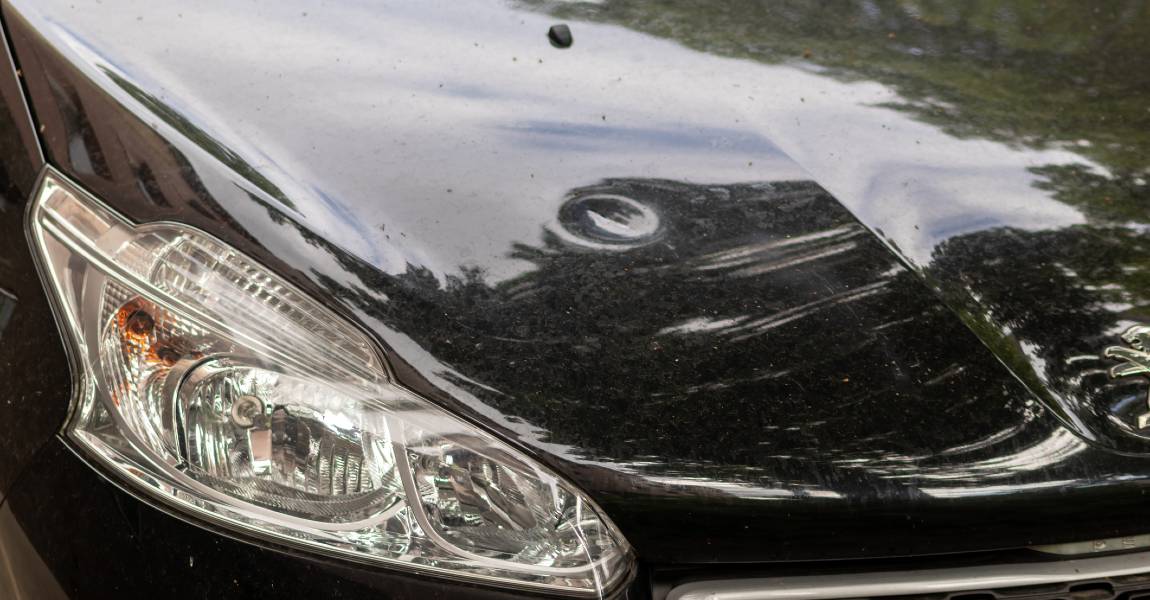
The Best Situations for PDR
PDR may not be suitable for all types of dent repair jobs. However, there are certain situations where it is the most efficient and effective option available.
PDR is an excellent choice for repairing small to medium-sized dents that have not damaged the paint or finish of the vehicle. These types of dents are common and often caused by incidents such as door dings, collisions, hail damage, and sports accidents.
PDR can save car owners both time and money in these situations because the repair process is quicker and less expensive than traditional body shop repairs. Additionally, PDR techniques preserve the car’s original factory finish, helping maintain its value. It’s a great option for those looking to restore their vehicle’s appearance to its original state without the added expenses and time commitment associated with traditional repairs.
Key Takeaways:
- PDR is a viable choice for small to medium size dents, provided that they have not caused any damage to the paint or finish of the vehicle.
- PDR is a cost-effective and time-efficient option for repairing dents caused by door dings, collisions, hail damage, or sports accidents.
Possible Reasons for Minor Dents Fixable with PDR
Small dents on your vehicle can be frustrating and unsightly. They can occur from various sources, ranging from hail damage to minor collisions. But fear not; PDR can often provide an efficient and cost-effective solution to these types of dents.
The following list outlines common causes of small dents that are eligible for repair through PDR techniques.
Hail Damage
Hailstorms can cause widespread damage to vehicles, leaving countless small dents on the car’s body. PDR is a popular and effective repair method for addressing this type of damage. Experienced technicians can skillfully remove dents from the vehicle’s body without damaging the paint or finish using specialized tools like body picks and metal rods.
Hail damage is a common reason for PDR repairs, particularly in areas that experience frequent hail storms. The beauty of PDR is that it can restore a vehicle to its original condition without compromising its factory finish. However, repairs are often limited to horizontal body panels that are exposed to direct hail hits.
Roofs, hoods, and trunks are typical areas of a vehicle that are commonly damaged by hail. Also, hail comes in varying sizes, leaving small to large dents on the vehicle. The number of dents sustained also determines whether PDR suits hail damage. Traditional dent repair may be necessary if the dents are too large or too many.
With the right experience and tools, PDR rods can be used to push out the dents to restore the vehicle’s appearance. In addition to hiring a PDR technician, DIY kits are also available for people who prefer to conduct dent repair at home. However, some DIY kits may not produce the same results as an experienced technician would.
Key Points:
- PDR is an effective method for fixing hail damage on horizontal body panels.
- Hail damage is usually found on a vehicle’s roof, hood, and trunk.
- The number and size of dents sustained affect whether PDR can be used.
- PDR rods and DIY kits can be used to address hail damage.
- PDR is an excellent option for repairing small dents caused by hail damage.
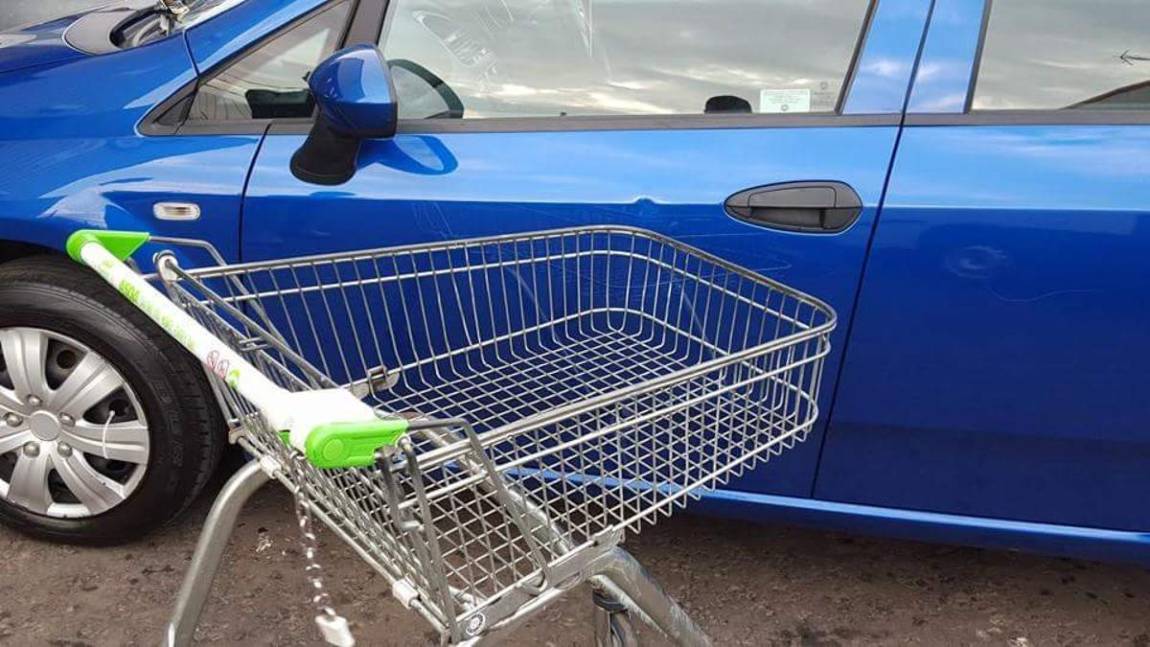
Shopping Cart Incidents
It’s a common scenario for car owners – you’re at the grocery store and return to your car only to find a dent courtesy of a wayward shopping cart. These types of dents are often small and shallow, making them perfect candidates for PDR repairs. With the use of glue pullers and a layer of glue, technicians can use specialized techniques to restore your vehicle to its original condition.
Key Takeaway:
- PDR is a cost-effective solution for repairing small dents caused by shopping carts or other minor collisions.
Damage Caused by Door Dings
Door dings are a common type of minor dent that can occur on any part of a vehicle’s body. These dents typically have a crescent shape with mild creasing on the inside. Door dings are often caused by swinging motions that come into contact with the vehicle’s body, like a door or a cart in a parking lot.
When it comes to repairing door dings with PDR, specific criteria must be met. The dent needs to be less severe and not have any cracked paint. If the creasing is mild, an experienced technician can utilize specialized tools to remove the dent and restore the vehicle’s original shape. In cases where the paint is not damaged, the PDR technique offers a quicker, more cost-effective solution than traditional dent repair methods.
In some cases, door dings can be the same as dents from a collision, meaning they are not always as minor as they seem. If the damage is more severe or extensive, the PDR technique may not be enough to restore the vehicle to its original condition. Therefore, consulting with an experienced technician is essential to determine the best course of action for repairing your vehicle’s door dings.
Key Takeaways:
- Door dings are a common cause of minor dents on the body of a vehicle, caused by swinging motions that come into contact with the body.
- PDR can offer an effective, cost-efficient solution for repair if the damage is less severe and the paint is not cracked or stripped.
- It’s essential to have an experienced technician assess the damage to determine the best course of action.
Collisions and Minor Accidents
Another common cause of small dents on cars is collisions with other vehicles or objects. These collisions can be due to minor accidents, where two vehicles touch each other or hit a concrete barrier, or due to incidents like backing up too quickly or driving over a high curb or speed bump. These collisions can result in small dings or dents on a car’s body panels, especially around the bumper area or the car’s sides.
Minor accidents can also occur during parking, where drivers may accidentally hit a pole or scrape against a wall or another car. These incidents can cause small dents, scratches, or paint damage, depending on the impact force
Key Takeaways:
- Collisions with other vehicles or objects can lead to small dents in a car’s body panels.
- Minor parking or backing-up accidents can result in small dings or scratches on a vehicle.
- PDR can effectively repair these dents without requiring repainting.
Minor Dents that are Caused by Sports-Related Accidents
Minor and shallow round dents caused by sports accidents can be effectively repaired through PDR. These dents are often caused by airborne sports equipment like basketballs, baseballs, soccer balls, and golf balls hitting a vehicle’s horizontal panels.
Repairing these types of dents through PDR involves using specialized tools that gently massage the dented areas without affecting the paint job or using body fillers. The process is efficient and can be completed in a few hours, making it a convenient solution for those who don’t have the time to leave their vehicle in a body shop. However, it’s essential to ensure that the factory paint is not showing any signs of cracking before proceeding with the repair.
Key Takeaways:
- Minor and round dents caused by sporting accidents can be addressed through PDR effectively.
- PDR tools are designed to massage the affected area without affecting the paint job or using body fillers.
Types of Dents Unlikely to be Repaired by PDR
It’s essential to note that certain types of dents are unlikely to be repaired effectively through the PDR method. These severe dents can only be repaired through the traditional dent repair process, which uses body fillers and painting to restore the vehicle to its original condition.
Deep and crease dents are some examples of the type of dents that cannot be repaired through PDR. These dents often affect a vehicle’s body lines and panels. They require more in-depth repairs that can only be accomplished through a traditional body shop approach.
Key Takeaways:
- Severe dents are unlikely to be repaired through the PDR method.
- Deep and crease dents require in-depth repairs that can only be accomplished through a traditional body shop approach.
Other Contributing Factors that Cause Damage to Car Surface
Apart from sports accidents, there are numerous other reasons why small dents may appear on a vehicle’s body panels. Falling objects, such as branches, acorns, or hail, can cause small dings on a car’s roof, hood, or trunk. These objects can fall from trees, buildings, or even other cars on the road. Hailstorms, in particular, can result in numerous small dents appearing on a car, affecting its resale value and overall appearance.
Shopping carts can also be the cause of small dents in vehicles. In parking lots or shopping centers, it’s common to see shopping carts left unattended or not secured properly. These carts can roll, hit a parked car, and leave a noticeable ding or dent. While these dents may be small, they can be unsightly, and repairs may be necessary to restore the vehicle’s appearance.
Key Takeaways:
- Falling objects like hail or acorns can cause small dents on a vehicle’s body panels.
- Unsecured shopping carts can also lead to small dents on parked cars.
What Auto Panels can be Fixed with PDR?
Paintless Dent Repair (PDR) is a cost-effective and efficient method of repairing small dents and dings on a vehicle’s body panels. Using specialized tools, PDR technicians can gently push the dented metal back into its original shape without using fillers or paint. This process helps to maintain the vehicle’s original factory finish and preserve its value.
The PDR process can easily and effectively repair Certain types of dents. By understanding what types of dents are suitable for PDR, vehicle owners can make more informed decisions about the best way to repair their vehicle and save time and money in the process. Let’s take a look at some of the body panels that can be repaired with PDR.
Key Takeaways:
- PDR is a cost-effective and efficient method of repairing small dents and dings without having to use fillers or paint
- Vehicle owners can make more informed decisions about how to repair their vehicles by understanding what types of dents are suitable for PDR.
Damaged Car Hoods can be Repaired with PDR
When it comes to repairing hoods with paintless dent repair (PDR), it’s important to understand the materials that most alloy and sheet metal hoods are made of. These materials are perfect candidates for PDR since they can be easily removed from the vehicle, allowing technicians to access the area underneath the hood to pop out dents. Small dents on hoods caused by hail damage, falling objects, or sports accidents can be repaired with PDR as long as the paint is intact and the dent isn’t too complex.
However, there are exceptions to this rule. Due to their unique makeup and structure, certain types of hoods, such as carbon fiber and fiberglass hoods, cannot be repaired with PDR. PDR technicians need proper training to understand the materials that can and cannot be repaired with PDR and to achieve the best results.
Key Takeaways:
- Alloy and sheet metal hoods are ideal candidates for PDR since they can be easily removed from the vehicle and accessed underneath to pop out dents.
- PDR can repair small dents caused by hail damage, falling objects, or sports accidents as long as the paint is still intact and the dent isn’t too complex.
- Carbon fiber and fiberglass hoods cannot be repaired with PDR and require the expertise of an experienced technician.
Find out more about How to Fix a Dent Without Damaging Your Cars Paint using PDR
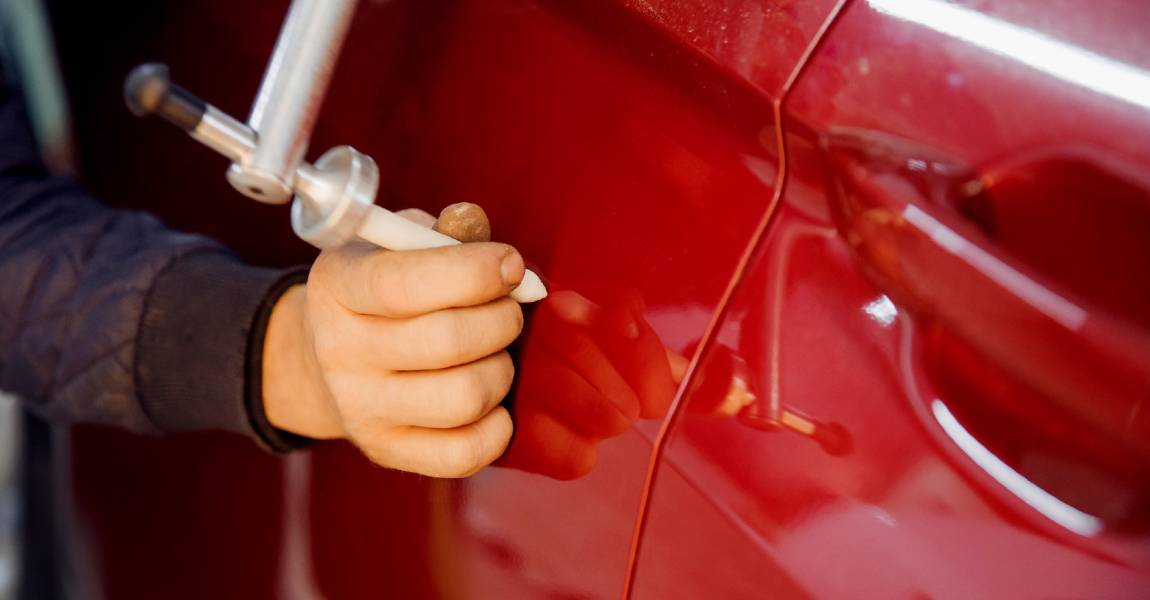
Majority of Car Doors can be Repaired with PDR
(PDR) is a commonly used method to repair car damage, particularly on doors. PDR technicians can use specialized tools to access the area behind doors and restore them to their original shape without damaging the paint.
Alloy and sheet metal doors on vehicles are ideal candidates for repair with PDR. The doors can be easily removed from the car, giving technicians access to the back of the door. As long as the paint is not cracked and the dent is not too complex, PDR can be used to restore the door to its original condition. PDR is also more cost-effective than traditional dent repair methods that require filling and repainting the affected area.
However, certain doors may not be able to be repaired with PDR. Plastic doors are not ideal for PDR since they require a different process to repair. Additionally, if the door has severe impact scratching that has caused paint damage, it may not be a good candidate for PDR. In such cases, traditional dent repair methods may be necessary to restore the door to its original condition.
Finding a qualified PDR technician to repair your vehicle’s doors is important. They have the experience and expertise to assess and repair the damage while maintaining your vehicle’s factory finish. A qualified technician will also have the proper training to understand which materials can and cannot be repaired with PDR, ensuring that the repair process is safe and effective.
Key Takeaways:
- The process of PDR has the ability to fix alloy and sheet metal doors on vehicles effectively.
- PDR technicians can easily access the area behind doors to restore them to their original shape, as long as the paint is not cracked and the dent is not too complex.
- Plastic doors and doors with severe impact scratching may not be good candidates for PDR.
- Finding a qualified technician to repair your vehicle is important to ensure a safe and effective repair process.
Can I Fix Car Fenders Using Paintless Dent Repair?
Generally, front fenders are prime candidates for PDR. Whether it’s a minor dent caused by a shopping cart or a hailstorm, PDR can be used to repair them, allowing the fender to be restored to its original form. Unlike traditional body repair methods, PDR does not require the use of body fillers or paint. Thus it is cost-effective and helps preserve the car’s original paint job. Front fenders are also easily removable, making accessing the area behind the dent simpler.
To access the area behind the dents, a PDR technician will need to remove the inner panel of the fender. Therefore, front fenders are ideal for PDR since most inner panels are removable with little effort. With access to the backside of the dent, the technician looks for the best point of entry to start working on the dent. A series of specialized tools, such as metal rods and body picks, are then used to massage the dent out of the fender from the inside out, resulting in a smooth and even surface.
Key Takeaways:
- PDR works best on front car fenders because they can be removed easily for access.
- A series of specialized tools are used in PDR to massage the dent out of the fender from the inside out.
Common Causes of Fender Dents
Small dents on front fenders are usually caused by common incidents such as hailstorms, low-speed fender benders, and parking lot accidents. Hail damage, in particular, is a common cause of small dents that PDR can fix on front fenders. Dents from minor collisions that have not damaged the paint and small dents and dings caused by parking lot mishaps can also be easily fixed with PDR.
However, PDR may not be the best solution for repairing front fenders in all situations. Complex dents on the fender’s body lines, which have affected the fender’s contour, may be difficult to repair completely, especially with PDR alone. In the case of these kinds of dents, a combination of traditional body repair methods, such as body fillers and paint, may be necessary to return the fender to its original condition.
Key Takeaways:
- Small dents that can be caused by hailstorms, low-speed collisions, and parking lot incidents are commonly repaired with PDR on front fenders.
- Complex dents on body lines may require traditional body repair methods and PDR to restore the fender fully.
PDR Quarter Panel Repair
Regarding quarter panels, PDR can be an effective solution for repairing dents, provided that the paint is still intact and the dent is not too complex. Access to the area behind the quarter panel is critical for a successful PDR repair, so it is important to work with an experienced PDR technician with the necessary expertise and specialized tools to get the job done right.
However, some dents are too sharp or complex to be repaired with PDR alone, especially if they have affected the body lines of the quarter panel. In these cases, traditional auto body repair techniques such as body fillers and paint may be required to restore the quarter panel to its original condition. It is important to note that using body fillers is necessary to reshape the dented area and create a smooth surface, so choosing a reputable auto body shop with experienced technicians who can perform these repairs to the highest standard is crucial.
Key Points:
- PDR can typically repair quarter panels if the paint and dent meet certain conditions.
- Access to the area behind the quarter panel is essential for successful PDR repairs.
- Dents that are too complex or affect body lines may require traditional auto-body repair with the use of body fillers.
PDR Roof Repair
When it comes to repairing dents on a vehicle’s roof, PDR can be a highly effective technique. However, the vehicle’s headliner must be removed to access the dents and complete the repairs. Once this is done, the PDR technician can easily access the area behind the dents to gently massage them out.
Roof dents caused by hail or round objects falling onto the vehicle can often be repaired with PDR, as they typically do not cause severe panel deformation or paint damage. In extreme cases, such as when the dent is too deep or has caused significant damage, body filler or even a new roof may be required. However, this is not the norm, and most roof dents can be repaired using PDR with excellent results.
Summary:
- PDR is an effective repair technique for most roof dents.
- Headliner removal is necessary for PDR repairs on the roof.
- Hail damage or round objects falling onto the vehicle are common causes of roof dents that PDR can repair.
- In extreme cases of severe deformation or paint damage, body filler or a new roof may be required for repairs.
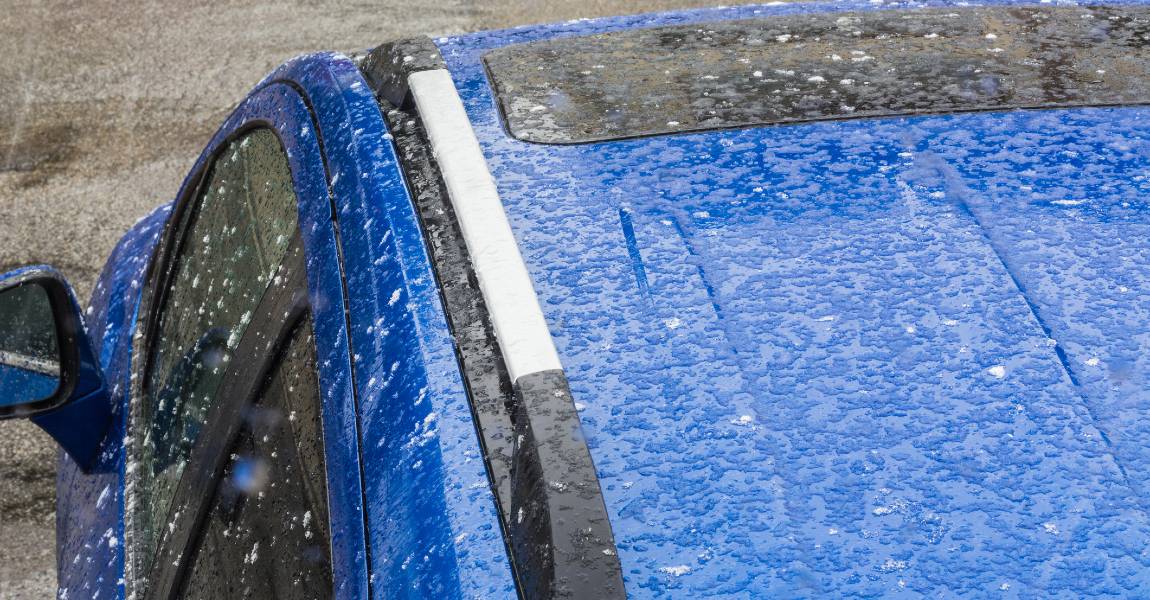
PDR Cannot Repair All Types of Material
While paintless dent repair (PDR) is an effective repair technique for many types of automobile dents, some materials cannot be repaired using PDR methods. In general, the PDR process requires that the metal panel be flexible enough to be manipulated and restored to its original shape without causing further damage or cracks in the paint.
Here are some materials that cannot be repaired using the PDR process.
1. Fiberglass
Fiberglass is a composite material commonly used to manufacture body panels on boats, RVs, and some automobiles. While the process of repairing fiberglass is similar to repairing metal panels, PDR cannot be used since the material is not flexible enough to be manipulated without causing further damage. As a result, traditional dent repair techniques involving fillers, sanding, and painting are necessary to repair dents on fiberglass panels.
2. Aluminum
Aluminum is a lightweight metal that is commonly used in the automotive industry to reduce weight and improve fuel efficiency. However, because aluminum is more brittle than steel, repairs to panels made with this material require specialized equipment, tools, and training. While some minor dents on aluminum panels can be repaired using PDR, larger dents and severe damage require traditional filler repairs, all of which require significant skill and expertise.
Key Takeaways:
- Due to their inflexibility and brittleness, PDR cannot be used to repair fiberglass or aluminum panels.
- Traditional repair techniques involving fillers, sanding, and painting are necessary to repair dents on fiberglass panels.
- Aluminum panels require specialized equipment and training for repair, and larger dents and severe damage require traditional repair techniques.
How Does the Type of Car Paint and Finish Affect the PDR Process?
Regarding PDR, the type of paint and finish on the vehicle can significantly affect the repair process. Some modern water-based acrylic polyurethane enamel paints have better elasticity than older paints. This elasticity allows the paint to stretch and flex without cracking or peeling, making it easier for experienced technicians to manipulate dents back to their original position without damaging the paint.
In contrast, some older paints may not have the same elasticity or resilience, making the PDR process more challenging. If the paint is not flexible, attempting to manipulate a dent could cause cracking or peeling, leaving the technician with no choice but to repaint the affected area. Therefore, it is important to consider the type of paint and finish on a vehicle before attempting PDR to avoid any damage and ensure the best possible results.
Key Takeaways:
- The type of paint and finish can significantly impact the PDR process.
- Modern water-based acrylic polyurethane enamel paints have better elasticity and are easier to repair using PDR than older paints.
- Older paints may not have the same elasticity or resilience, potentially leading to cracking or peeling during the PDR process.
What Type of Vehicles Are Commonly Repaired with PDR?
(PDR) Paintless dent repair is an effective method for repairing various types of vehicles. As long as the vehicle is constructed with one of the repairable materials, it can be repaired using the PDR process. The repairable materials include aluminum, high-strength steel, and traditional steel.
PDR technicians have worked on various types of vehicles, including coupes, sedans, wagons, high-end sports cars, trucks, SUVs, Jeeps, crossovers, vans, minivans, and panel vans. Whether the vehicle has a unibody construction or body on frame, paintless dent repair can remove dents from the vehicle and restore it to its original condition. With PDR, even dents caused by shopping carts, hailstorms, or dents from automobiles/cars are easily repaired without the need for extensive repair procedures.
Key Takeaways:
- PDR can be used on various types of vehicles as long as they are made from aluminum, high-strength steel, or traditional steel.
- PDR technicians can work on coupes, sedans, wagons, sports cars, trucks, SUVs, Jeeps, crossovers, minivans, and panel vans.
- PDR can restore the vehicle to its original condition, regardless of its construction type.
How Does Metal Memory Affect the PDR Process?
One essential factor to consider when working with PDR is metal memory. When metal is shaped, it retains some amount of its original form, which applies to any type of metalworking, including dent repair. Metal memory significantly impacts the PDR process since it affects the malleability of the metal, making it easier or harder to fix a dent. Metal memory can either work for or against the technician, as it can make it difficult to get the metal back to its original position after a dent.
Key Takeaways:
- Metal memory refers to the tendency of the metal to revert to its original shape.
- Metal memory can require extra pressure to force the metal back into its normal position during the PDR process.
Types of Dents that Cannot be Fixed with PDR:
Sometimes, the metal on a vehicle is stretched beyond repair, preventing a PDR technician from repairing a dent using traditional techniques. When body panels are stretched, the metal becomes thinner in areas around the dent, making it almost impossible to push out a dent using PDR. Dents in areas like body lines, creased dents, and severe dents sometimes require the use of body fillers or panel replacements. These dents cannot be restored to their original condition through PDR since the stretched metal has exceeded the limit of metal memory.
Key Takeaways:
- PDR cannot be used to repair deep, creased, or dents in body lines or severely damaged panels.
- In such cases of stretched metal, body filler or panel replacement is necessary to repair the damage fully.
Metal Stretching and Their Effects on PDR:
During PDR, metal stretching can make it difficult for technicians to remove dents. In the case of stretched metal, the process of removing dents becomes more complicated; the stretched metal can cause cracks or increase the size of the dent when pushed excessively. This can cause irreparable damage to the entire panel that could require repair by using body filler or even replacing the entire panel. As such, it is essential to consider any metal stretching before undertaking PDR to determine if it can be done without causing further damage that could result in costly repairs.
Key Takeaways:
- Stretching of metal can make it difficult for PDR technicians to remove dents.
- For complex dents accompanied by stretched metal, body filler or panel replacement may be the only viable options for repair.
What is the Average PDR Cost?
The paintless dent repair cost varies depending on the extent and complexity of the damage. Factors that can affect the cost include the size and location of the dent, the type of vehicle, and the number of dents. While minor dents, such as those caused by shopping carts, can cost between $75 and $125, more complex dents resulting from hail damage or severe accidents can cost up to $400 or more. It is essential to note that dents in hard-to-reach areas or those requiring specialized tools may also increase the cost of PDR.
Key Takeaways:
- Factors that affect the cost of PDR include the damage’s extent and complexity, the dent’s location, and the type of vehicle.
- Minor dents can cost between $75 and $125, while more complex dents can cost up to $400 or more.
Body Parts and Vehicle Types Ideal for PDR
Some areas of a vehicle are more ideal for PDR than others. Dents on flat surfaces like fenders, hoods, doors, and quarter panels are generally easier to fix than dents on body parts with more complex shapes, such as bumpers and rooflines. Additionally, small to mid-sized vehicles are more suitable for PDR. While larger vehicles can undergo this process, their size often makes it challenging to reach certain areas of the vehicle that need repair.
Key Takeaways:
- Using PDR, body parts with flat surfaces are easier to fix than those with more complex shapes.
- Small to mid-sized vehicles are more ideal for PDR than larger vehicles.
PDR is Cheaper and Eco-Friendly
PDR is a cheaper and more eco-friendly alternative to traditional dent repair. Unlike traditional repair, PDR does not require the use of body fillers or paint, making it a more affordable option. Additionally, PDR produces less waste, making it an eco-friendly option. Vehicle owners can save money and resources by opting for PDR while restoring their cars to their original condition.
Key Takeaways:
- PDR is a cheaper alternative to traditional dent repair.
- PDR produces less waste, making it an eco-friendly option.
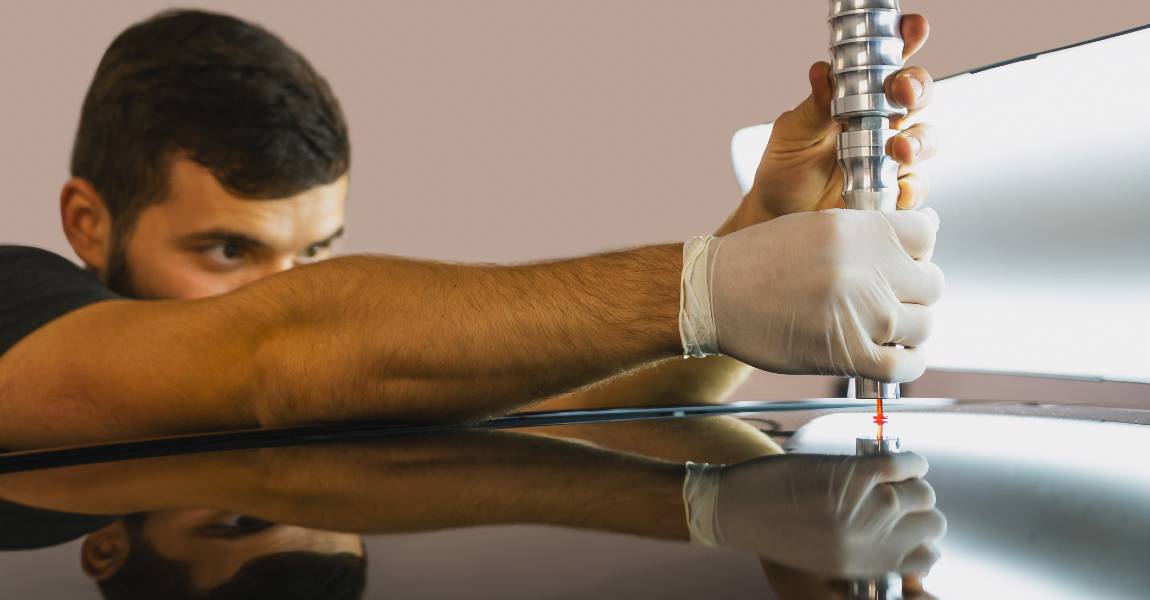
Tips for Finding a Skilled PDR Technician
When looking for a qualified PDR technician, start by conducting research online. Look for reputable technicians in your area and read online reviews from previous customers. Alternatively, ask for recommendations from friends and family members who may have had a positive experience with a PDR technician in the past.
Once you have identified potential technicians, ensure that they have been in business for several years and offer a lifetime warranty on their work. This demonstrates their commitment to quality service and gives you added peace of mind.
When selecting a technician for paintless dent repair, it is recommended to choose one who is a member of a professional PDR association, such as the National Paintless Dent Repair Association, as this indicates a dedication to industry standards and continuous education.
To guarantee safe and effective PDR, confirming that the technician possesses appropriate training, experience, and tools is important. By following these steps, you can locate a skilled PDR technician who will deliver quality service and return your vehicle to its original state.
Key Takeaways:
- Conduct research online, read reviews, or ask friends and family members for recommendations.
- Choose a technician who has been in business for several years and offers a lifetime warranty on their work.
- Choose a technician from an association like NPDR for PDR work.
- When selecting a technician for PDR, it is important to verify that they possess adequate training, experience, and equipment to carry out the job in a secure and efficient manner.
What are Common Misconceptions About PDR?
Several common misconceptions about PDR can lead to confusion and misinformation. One of the most common myths is that PDR is only suitable for hail damage. In reality, PDR can be used to repair various types of dents caused by different events, such as parking lot mishaps or shopping cart dents. PDR is also effectively restoring the body panel to its original condition rather than covering up the damage using body fillers and paint.
Another common misunderstanding about PDR is that anyone can perform the technique with the right tools. However, performing PDR without adequate training and tools is not recommended. PDR technicians undergo extensive training to learn how to remove dents without damaging the surrounding paint or body panel. Without proper techniques and tools, attempting PDR can result in more damage and lead to costly repairs.
Key Takeaways:
- PDR is not just for hail damage and can repair various types of dents.
- Attempting PDR without proper training and tools can cause more damage.
- PDR is fast and affordable compared to regular dent repair.
PDR vs. Traditional Dent Repair
When repairing dents on a vehicle, there are generally two options available: Paintless Dent Repair (PDR) or Traditional Dent Repair. While both methods can achieve similar results, some key differences between the two are important to understand. This article’ll explore those differences and provide insight into your situation’s best method.
PDR vs. Traditional Dent Repair: A Comparison
Both Paintless dent repair (PDR) and traditional dent repair techniques have their unique advantages and disadvantages. PDR is generally less invasive, with no need for painting or using body fillers, making it a faster and more cost-effective option for minor dents.
Traditional dent repair, on the other hand, can handle more severe damage, like creases and larger dents, but often requires a longer repair process and a full paint job.
Key Takeaways:
- PDR is a non-invasive and cost-effective option for minor dents
- Traditional dent repair is best for severe damage but often requires a longer repair process and a full paint job.
How Good is PDR?
(PDR) This innovative technique has significantly changed how car dents are repaired. One of the most significant advantages of PDR is that it is non-invasive. It is a completely different approach from traditional dent repair, as it uses specialized tools and techniques to remove dents from a car’s body panel without damaging the paint. That means no sanding, filler, or repainting is necessary. The result is a dent-free car that looks as good as new.
PDR also preserves the original factory finish of a car. Using the PDR technique removes dents and dings without affecting the paintwork, a feature that traditional dent repair can’t boast. This is especially important for custom paint jobs, high-end cars, and exotic cars with unique and irreplaceable finishes. Additionally, the non-invasive nature of PDR allows for a faster repair process and is the least invasive way to repair a dent or ding.
Key Takeaways:
- The PDR process is a method of dent removal for car body panels that does not cause damage to the paint.
- PDR preserves the original factory finish of a car and is the least invasive way to repair a dent or ding.
Do It Yourself PDR Kits
Do It Yourself Paintless Dent Repair (PDR) kits have grown in popularity over the years, allowing car owners to remove dents without having to visit a professional. DIY kits offer a sense of convenience as car owners can save both time and money by performing repairs on their own. However, it is important to note that despite their advantages, DIY PDR kits have both pros and cons.
One of the main advantages of DIY PDR kits is the cost. Professional dent repairs can be costly, whereas DIY kits are more affordable, making them a convenient option for those who want to save money. Another advantage is that DIY PDR kits have come a long way since their invention, with people now able to use these kits to remove dents without causing further damage to their vehicles. However, caution still needs to be taken, especially for those new to DIY PDR, as the vehicle’s safety is paramount, and one mistake can lead to considerable damage.
Key Takeaways:
- DIY PDR kits offer convenience and affordability for car owners who want to save money.
- Proper caution is required, especially for beginners, to ensure that the repair process is safe and effective.
Choosing a DIY PDR kit
When choosing a DIY PDR kit, it is important to consider purchasing a kit with the right tools and how-to instructions to ensure safe usage. Some top-reviewed DIY PDR kits to consider include Ausnew PDR tool kit, GLISTON PDR kit, YOOHE PDR tools, and ARISD PDR tool kit. These kits are effective, versatile, and affordable, making them popular among DIY PDR enthusiasts.
Key Takeaways:
- Top reviewed and affordable DIY PDR kits include GLISTON, YOOHE, and ARISD PDR tool kits
- Choose a DIY PDR kit with the right tools and instructions for proper usage.
Ultimately, DIY PDR kits can save you time and money when it comes to removing dents from your vehicle. However, it is important to understand the pros and cons and potential risks to your vehicle. With proper caution and care, you can successfully remove dents and bring your vehicle back to its original condition by choosing the right DIY PDR kit.
DIY Dent Repair vs. Professional PDR
DIY dent repair kits have become increasingly popular due to their affordability and convenience. However, there are significant differences between DIY dent repair vs. professional paintless dent repair (PDR) services that customers should be aware of before attempting to perform PDR independently. DIY dent repair is a simple and quick fix that can be done at home, but it is limited in terms of the size and type of dent that can be repaired. On the other hand, professional PDR technicians have years of experience, training, and access to specialized tools that enable them to repair both minor and severe dents quickly and effectively.
Key Takeaways:
- DIY dent repair kits have limitations in terms of the size and type of dents that can be repaired.
- Professional PDR technicians have the experience, training, and specialized tools to repair both minor and severe dents.
Dangers of Attempting PDR Without Proper Training:
Attempting to perform PDR on your own without the proper training can be dangerous and may cause further damage to your vehicle. PDR requires high precision and skill; a single mistake may damage the body panel or paint job. Additionally, PDR tools can be dangerous to use, and DIY enthusiasts may lack the expertise and knowledge to use them safely.
Key Takeaways:
- Attempting to perform PDR on your own without proper training may be dangerous and may cause further damage to your vehicle.
- PDR tools can be dangerous to use, and DIY enthusiasts may lack the expertise and knowledge to use them safely.
Benefits of Seeking Professional PDR Services:
Professional PDR services provide numerous benefits that DIY dent repair cannot replicate. PDR technicians have years of experience and the proper training necessary to repair dents safely and effectively. They also have specialized tools such as glue pullers, metal rods, and body picks, enabling them to repair minor and severe dents without using body fillers or compromising the vehicle’s original condition. Moreover, professional PDR services may be covered by insurance policies, making it a cost-effective option for those who want to restore their vehicle to its factory finish.
Key Takeaways:
- Professional PDR services provide numerous benefits, such as experience, training, specialized tools, and insurance coverage.
- PDR technicians can repair both minor and severe dents without using body fillers or compromising the vehicle’s original condition.
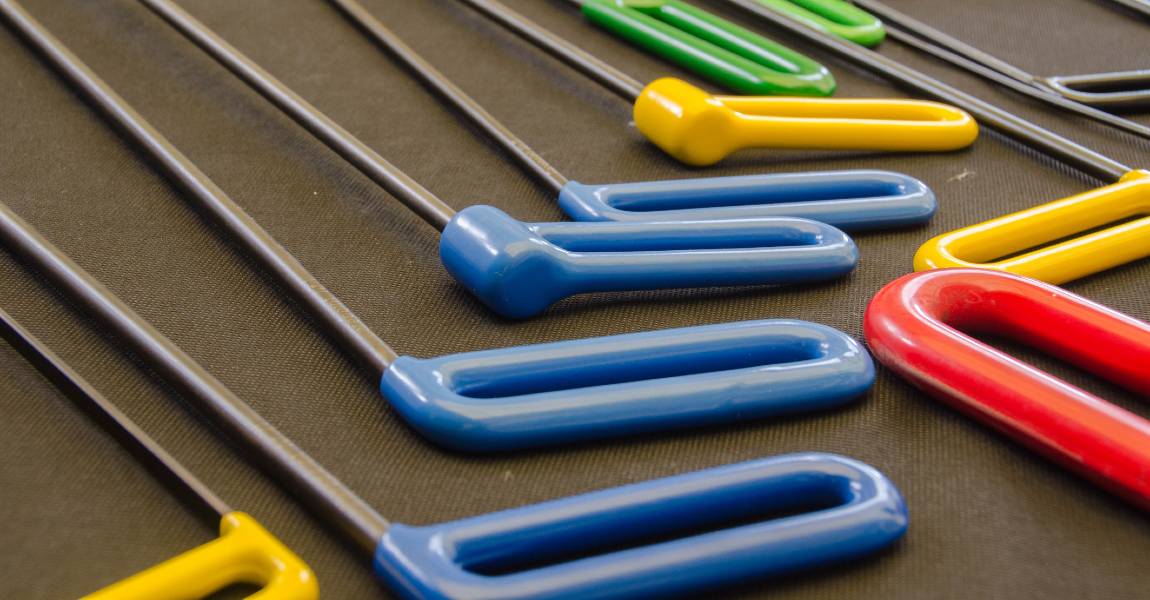
PDR Techniques and Specialized Tools
PDR technicians use various tools and techniques to repair dented metal panels without the need for painting or body fillers. The key technique used in PDR is manipulating the metal from the inside by carefully pushing or massaging it back into place. This method is preferred because it preserves the vehicle’s original finish and avoids additional costs associated with painting and refinishing.
Specialized Tools and How They Work
Numerous specialized tools are used to perform PDR, each with its unique purpose. These tools include metal rods, wire tools, door hooks, suction cups, and slide hammers. Metal rods are the most commonly used PDR tools as they allow technicians to exert a precise amount of force while working from the inside of the panel. Similarly, wire tools are used to reach tight spaces, and door hooks are ideal for accessing dents on door panels. Suction cups are used to pull out larger dents, while slide hammers are used for more extensive damage.
Key Takeaways:
- PDR manipulates metal panels from the inside, avoiding painting and body fillers.
- Specialized PDR tools include metal rods, wire tools, suction cups, and slide hammers, each with its unique purpose.
Cold Glue in PDR
Cold glue is another PDR tool, commonly used to “pull” dents out. The cold glue technique involves placing a small amount of glue on a plastic tab, which is then attached to the dent. Once the glue sets, a tool is used to apply force in the opposite direction, gradually pulling the dent out.
Key Takeaways:
- Cold glue is used in PDR to pull dents out gently.
- The technique involves gluing a small tab onto the dent and gently pulling it back into place.
FAQs
Here are some of the frequently asked questions related to PDR:
Is PDR suitable for all types of dents?
PDR is most effective on minor dents such as dings and dents from shopping carts. However, PDR can also be used to repair larger and more severe dents caused by hail damage or accidents, as long as the paintwork is not damaged.
How long does it take to complete PDR?
The time required to complete PDR depends on the damage’s extent and the dent’s location on the vehicle. Most minor dents can be repaired within a few hours, while more extensive damage may take longer.
How much does PDR cost?
The price of PDR is determined by factors such as the damage’s severity, the dent’s location, and the technician’s expertise. Typically, PDR is a less expensive option compared to conventional dent repair, with an average cost range of $75 to $150 per dent.
Does PDR affect the resale value of a car?
No, PDR does not affect the resale value of a car. In fact, it can increase a car’s value by restoring it to its original condition.
Other important FAQs:
Where Can I Find an Expert PDR Tech?
Choosing someone with proper training and experience is important when looking for a qualified PDR technician. Look for technicians who have been certified and have several years of experience in the field.
What is the Difference Between PDR and Traditional dent repair?
The main difference between PDR and traditional dent repair is that PDR does not involve using body fillers or painting. Instead, it involves manipulating the metal panels from the inside to restore them to their original shape.
Conclusion Guide to Paintless Dent Repair
In conclusion, Paintless Dent Repair (PDR) is a cost-effective and efficient method of repairing vehicle dents, including minor dents and hail damage. With a high success rate and no impact on the vehicle’s factory finish, it’s no wonder why PDR has become a popular alternative to traditional dent repair methods.
The benefits of PDR include affordability, timely completion, and preservation of the original factory finish. PDR can repair common dents such as those caused by shopping carts, hail damage, and single or shallow dents. When seeking a qualified PDR technician, looking for those with proper training, certification, and years of experience is important.
PDR should be a top consideration for anyone looking to quickly and cost-effectively repair dents on their vehicle without sacrificing its original factory finish.
Keep coming back to ProTech Auto Shield for more guides and news in the world of automobile detailing. Or contact ProTech Auto Shield for more information at 303.423.2841.





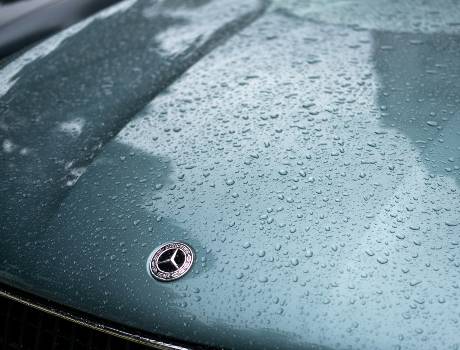
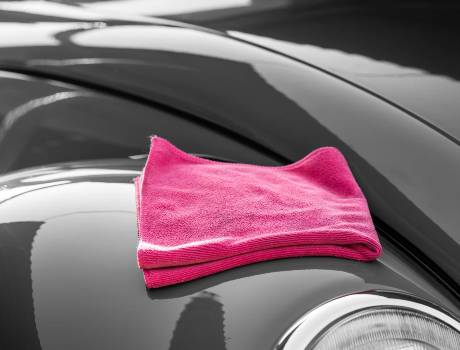

WHAT OUR CLIENTS ARE SAYING